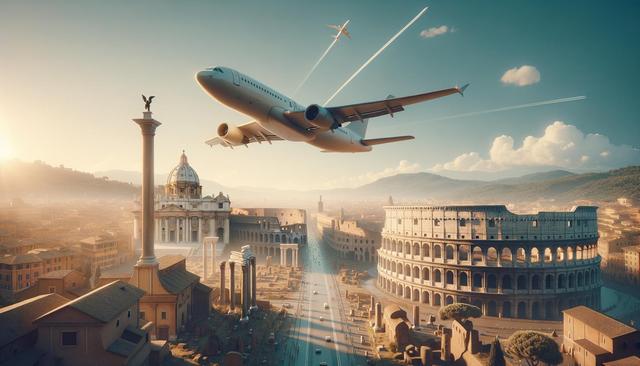Planning Your Flight to Rome: What to Know Before You Go
A flight to Rome is more than just a journey—it’s the first step into a city where history, culture, and cuisine come alive.

Choosing the Right Time to Fly
Booking a flight to Rome involves more than just selecting a date—it’s about aligning your travel plans with the city’s seasonal rhythm. Rome experiences a Mediterranean climate, with hot summers and mild winters. The most popular months to visit are April to June and September to October, when the weather is pleasant and tourist sites are less crowded than in peak summer. If you’re looking to avoid long lines and inflated prices, consider flying in the shoulder seasons. Winter flights can also be an appealing option for budget-conscious travelers, as airfare and accommodation rates tend to be lower.
Flights to Rome are generally more expensive around major holidays and during the summer months. Monitoring fare trends and booking in advance can help secure more attractive pricing. Use fare comparison tools and set alerts to track deals from different airlines. Flexibility with your travel dates and times can also open up more affordable options.
Airports and Arrival Options
Rome is served by two major airports: Leonardo da Vinci International Airport (commonly known as Fiumicino) and Ciampino Airport. Fiumicino is the larger of the two and handles most international flights. It offers a wide range of amenities, efficient public transport links, and car rental services. Ciampino, on the other hand, is smaller and often caters to low-cost carriers and charter flights. Knowing where you’ll land can help you plan your transport into the city more effectively.
Once you arrive, there are several ways to reach the city center:
- Leonardo Express: A non-stop train from Fiumicino to Termini Station, taking about 32 minutes.
- Regional trains: Slower but less expensive, connecting to various parts of Rome.
- Airport buses: Operated by several companies and stopping at key city locations.
- Taxi services: Fixed fares are available, but always confirm the rate before departure.
It’s a good idea to have some euros on hand for minor expenses upon arrival, such as public transportation or snacks.
What to Expect on the Flight
Depending on your departure location, a flight to Rome can vary greatly in duration. Transatlantic flights from North America can take between 8 to 10 hours, while flights from other European cities typically last 2 to 3 hours. Long-haul flights often offer in-flight meals, entertainment systems, and other amenities to make the journey comfortable. If you’re flying overnight, consider bringing a neck pillow, eye mask, and earplugs to help you rest.
It’s also helpful to familiarize yourself with the customs regulations and immigration procedures before landing. Ensure your passport is valid for at least six months beyond your travel dates, and check whether a visa is required for your nationality. Most tourists from the EU, US, and other select countries can enter Italy for up to 90 days without a visa.
To stay comfortable during the flight, consider the following tips:
- Drink plenty of water to stay hydrated.
- Stretch periodically to improve circulation.
- Pack light layers in your carry-on to adjust to changing cabin temperatures.
Preparing for Your Stay in Rome
Arriving in Rome is just the beginning of your adventure. Preparing for the cultural differences and practical aspects of your stay can make your trip smoother. English is widely spoken in tourist areas, but learning a few basic Italian phrases can go a long way in enhancing your experience. Common expressions such as “Per favore” (please), “Grazie” (thank you), and “Dov’è il bagno?” (Where is the bathroom?) are useful to know.
Rome’s historic center is walkable, but comfortable footwear is essential due to the cobblestone streets. Public transportation, including buses, trams, and the metro, is affordable and efficient for visiting major attractions. Travel passes are available for tourists and can save you time and money during your stay.
It’s also wise to have a plan for staying connected. Many travelers opt for local SIM cards or portable Wi-Fi devices to ensure reliable internet access. Additionally, downloading navigation and translation apps can help you find your way and communicate more easily.
Tips for a Smooth Return Home
When it’s time to return home, planning ahead can help make your departure from Rome stress-free. Be sure to check your flight details and airport terminal information in advance. Arrive early to allow time for security checks, tax refund claims (if applicable), and any unexpected delays. Fiumicino Airport, in particular, can be busy during peak travel periods, so giving yourself a time cushion is advisable.
Before heading to the airport, double-check that you’ve packed all important items such as your passport, boarding pass, and any souvenirs or gifts. If you’ve purchased items eligible for VAT refund, make sure to follow the proper procedures at the airport and arrive with ample time to process the paperwork.
Depending on your airline, online check-in may be available up to 24 hours before your flight. This can save time and offer better seat selection. Also, keep an eye on your airline’s baggage policies to avoid excess fees or delays at the check-in counter.